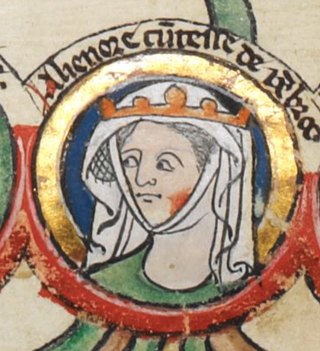Related Research Articles
The 1270s is the decade starting January 1, 1270, and ending December 31, 1279.

Edward I, also known as Edward Longshanks and the Hammer of the Scots, was King of England from 1272 to 1307. Concurrently, he was Lord of Ireland, and from 1254 to 1306 ruled Gascony as Duke of Aquitaine in his capacity as a vassal of the French king. Before his accession to the throne, he was commonly referred to as the Lord Edward. The eldest son of Henry III, Edward was involved from an early age in the political intrigues of his father's reign. In 1259, he briefly sided with a baronial reform movement, supporting the Provisions of Oxford. After reconciling with his father, he remained loyal throughout the subsequent armed conflict, known as the Second Barons' War. After the Battle of Lewes, Edward was held hostage by the rebellious barons, but escaped after a few months and defeated the baronial leader Simon de Montfort at the Battle of Evesham in 1265. Within two years, the rebellion was extinguished and, with England pacified, Edward left to join the Ninth Crusade to the Holy Land in 1270. He was on his way home in 1272 when he was informed of his father's death. Making a slow return, he reached England in 1274 and was crowned at Westminster Abbey.

Llywelyn ap Gruffudd, Llywelyn II, also known as Llywelyn the Last, was Prince of Gwynedd, and later was recognised as the Prince of Wales from 1258 until his death at Cilmeri in 1282. Llywelyn was the son of Gruffudd ap Llywelyn ap Iorwerth and grandson of Llywelyn ab Iorwerth, and he was one of the last native and independent princes of Wales before its conquest by Edward I of England and English rule in Wales that followed, until Owain Glyndŵr held the title during the Welsh Revolt of 1400–1415.

Robert Kilwardby was an Archbishop of Canterbury in England and a cardinal. Kilwardby was the first member of a mendicant order to attain a high ecclesiastical office in the English Church.
Robert Burnell was an English bishop who served as Lord Chancellor of England from 1274 to 1292. A native of Shropshire, he served as a minor royal official before entering into the service of Prince Edward, the future King Edward I of England. When Edward went on the Eighth Crusade in 1270, Burnell stayed in England to secure the prince's interests. He served as regent after the death of King Henry III of England while Edward was still on crusade. He was twice elected Archbishop of Canterbury, but his personal life—which included a long-term mistress who was rumoured to have borne him four sons—prevented his confirmation by the papacy. In 1275 Burnell was elected Bishop of Bath and Wells, after Edward had appointed him Lord Chancellor in 1274.

Eleanor de Montfort, Princess of Wales and Lady of Snowdon was an English noblewoman and Welsh princess through her marriage to Llywelyn ap Gruffudd, who was Prince of Gwynedd, and later, Prince of Wales. She was the daughter of Simon de Montfort, 6th Earl of Leicester and Eleanor of England. She was also the second woman who can be shown to have used the title Princess of Wales.

Eleanor of England was the youngest child of John, King of England and Isabella of Angoulême.

Amaury de Montfort was the third son of parliamentary pioneer Simon de Montfort, 6th Earl of Leicester, and Eleanor of England, daughter of King John.

Edmund of Almain was the second Earl of Cornwall of the fourth creation from 1272. He joined the Ninth Crusade in 1271, but never made it to the Holy Land. He was the regent of the Kingdom of England from 1286 to 1289 and the High Sheriff of Cornwall from 1289 to 1300.
Events from the 1310s in England.
Events from the 1320s in England.
Events from the 1340s in England
This article is about the particular significance of the century 1201–1300 to Wales and its people.
Events from the 1290s in England.
Events from the 1260s in England.
Events from the 1240s in England.
Events from the 1230s in England.
Events from the 1220s in England.
Events from the 1200s in England.
References
- 1 2 3 4 5 6 7 8 9 10 11 12 13 14 15 Palmer, Alan; Palmer, Veronica (1992). The Chronology of British History. London: Century Ltd. pp. 88–90. ISBN 0-7126-5616-2.
- 1 2 3 4 5 6 7 Williams, Hywel (2005). Cassell's Chronology of World History . London: Weidenfeld & Nicolson. pp. 146–148. ISBN 0-304-35730-8.
- ↑ Historic England. "Hailes Abbey (328158)". Research records (formerly PastScape). Retrieved 2020-09-13.
- ↑ Baldwin, Philip Bruce (2014). Pope Gregory X and the Crusades. Boydell Press. p. 43.
- ↑ Slack, Corliss (2009). The A to Z of the Crusades. Rowman & Littlefield. p. 36. ISBN 978-0-8108-6815-1.
- ↑ "Library & Archives – History". Oxford: Merton College. Archived from the original on 2012-05-13. Retrieved 2012-05-08.
- ↑ Perrin, W. G. (1922). British Flags. Cambridge University Press. p. 37.
- ↑ "Medieval English Hammered Farthings - Edward I - intro" . Retrieved 2010-09-12.
- ↑ Peck, C. Wilson (1960). English Copper, Tin and Bronze Coins in the British Museum 1558–1958. London: Trustees of the British Museum. p. 2. OCLC 906173180.
- ↑ "The Royal Mint at the Tower of London". Archived from the original on 2007-12-20. Retrieved 2007-12-03.
- ↑ Gillingham, John; Griffiths, Ralph A. (2000). Medieval Britain: a very short introduction . Oxford University Press. p. 61. ISBN 978-0-19-285402-5.